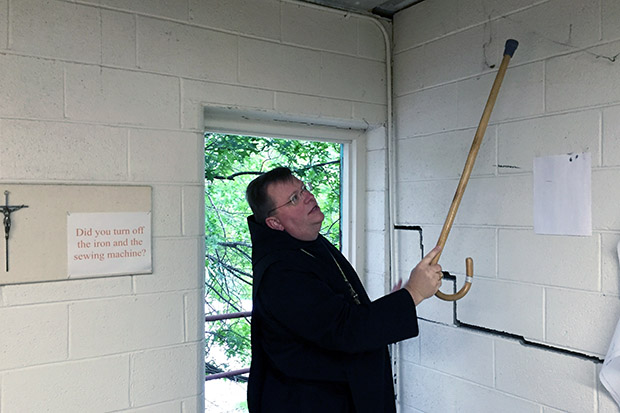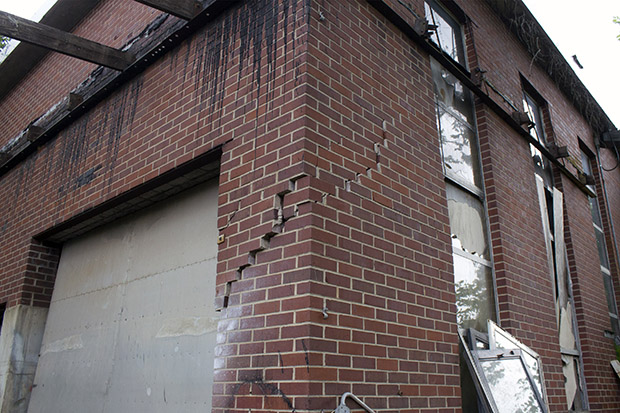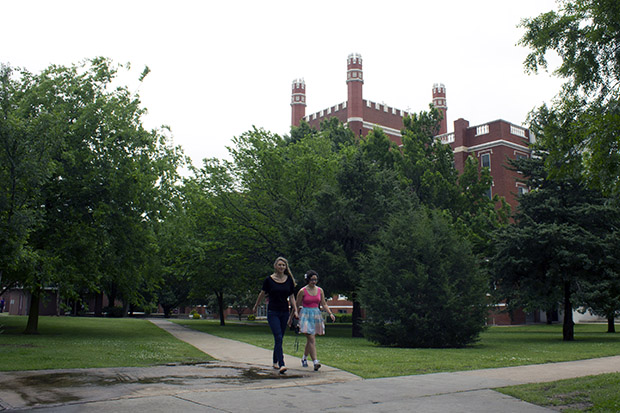
Abbot Lawrence points out cracks in
Joe Wertz / StateImpact Oklahoma


Abbot Lawrence points out cracks in
Joe Wertz / StateImpact Oklahoma

Joe Wertz / StateImpact Oklahoma
Abbot Lawrence Stasyszen of St. Gregory's Monastery traces cracks in the walls of the monk's workshop, which was damaged in a 5.7-magnitude earthquake that struck the nearby city of Prague in November 2011.
The rate of earthquakes in Oklahoma appears to be accelerating, and the state is responding.
Lawmakers have scheduled capitol hearings and oil and gas regulators will soon issue stricter guidelines on disposal wells linked to the shaking. Future earthquakes are a big concern, but one Oklahoma institution is still dealing with the damage one quake caused nearly four years ago.
St. Gregory’s University is an Oklahoma earthquake icon. When the 5.7-magnitude quake struck near the city of Prague in November 2011, one of the school’s century-old, Tudor Gothic-style towers collapsed. Another started spitting bricks.
The earthquake is Oklahoma’s largest recorded with modern instruments. It’s also the largest earthquake anywhere that scientists have linked to disposal wells used by the oil and gas industry. Two people were injured. None at St. Gregory’s.
The quake and the startling images of the crumbling towers brought a lot of attention to the university. Lesser known is the fact that the damage and the financial toll of the 2011 quake still plague St. Gregory’s today.
St. Gregory’s is a Catholic university and monastery in Shawnee. The spiritual work of the monks at the abbey is on full display behind stained glass and dark wood, where, on my visit in May 2015, men in dark, floor-length robes were huddled in alcoves with leather-bound books.
But the noisier, messier, more earthly work of St. Gregory’s monks is carried out in a field behind the monastery.
Abbot Lawrence Stasyszen gave me a tour of the monk’s workshop, which houses the monastery’s wood and metal shop, sewing and shoe-repair tools and the garage where brothers maintain vehicles and various machines. The building also hosts a chicken hatchery and beekeeping supplies.
The building looks like it’s been split in half.

Joe Wertz / StateImpact Oklahoma
Structural engineers have condemned a workshop used by monks at St. Gregory's University in Shawnee, Okla.
“You can see the cracks coming down again and the separation of the cinder block walls,” Stasyszen says, tracing the fissure with his cane.
Sunlight shines through the gaps. On the second story of the workshop, the floors are buckled and wavy.
“We had two outside engineering firms examine the building and both have condemned the building,” Stasyszen says.
The workshop is unfixable. The broken building will have to be demolished and replaced, an effort that would cost hundreds of thousands of dollars and require a big, public fundraising campaign, Stasyszen says.
Stasyszen says there are no immediate plans to raise money for a new workshop. That’s because, in true monk fashion, others’ earthquake needs come first. And right now, the university next to the monastery still hasn’t recovered from that 2011 earthquake.

Joe Wertz / StateImpact Oklahoma
Harley Lingerfelt, vice president of operations at St. Gregory's University.
St. Gregory’s University is small, and the size of the school’s budget reflects that. Only 380 students live on campus, says Harley Lingerfelt, the university’s vice president of operations.
“When the earthquake hit, it provided us a really hard hit to our budget, which we are still trying to overcome today,” he says.
The November 2011 earthquake toppled one tower at the school’s signature building, Benedictine Hall, which was built in 1915 and features prominently on the school’s logo. The shaking knocked a large hole in another tower, which started “spitting bricks” onto the ground below, Lingerfelt says.
The two towers have been repaired and retrofitted to be more earthquake-resistant.
Long before the November 2011 earthquake, university officials started a campaign to raise millions to restore the historic building, which hosts classrooms and nearly all of the school’s administrative offices. Lingerfelt says much of that money was diverted to earthquake repairs.
“I can’t give you the exact amount, but it was considerable,” he says.

Joe Wertz / StateImpact Oklahoma
Students walking near Benedictine Hall, an iconic, century-old building at St. Gregory's University. The November 2011 earthquake toppled one of the towers and caused major damage to another.
Oklahoma’s Supreme Court ruled in June that a woman injured in the 2011 Prague earthquake can continue a lawsuit seeking damages from oil and gas companies operating disposal wells in the area. A similar lawsuit over property damage has also been filed. Both lawsuits are being closely watched by worried residents and the energy and insurance industries.
Oklahoma officials acknowledged in April what scientists writing in peer-reviewed research papers have said for years: Oil and gas activity is likely fueling the state’s massive surge in earthquakes. The court cases suggest the next battle could be over who pays for the damages. The situation at St. Gregory’s shows how complicated and costly even “moderate” earthquakes — the classification given to 5.7-magnitude temblors like the one that hit Prague — can be.
Abbot Lawrence Stasyszen is round, soft and funny, but his light humor and laughter often leads to thoughtful observations. He says monasteries represent commitment. When monks enter the brotherhood, they make a vow of stability.
“And that means we commit to a particular place, a particular monastery,” he says. “That’s why monasteries have been centers of agriculture and architecture and learning.”
Stasyszen says the monks of St. Gregory’s are committed to that vow of stability — even if the earth below them is shaky.